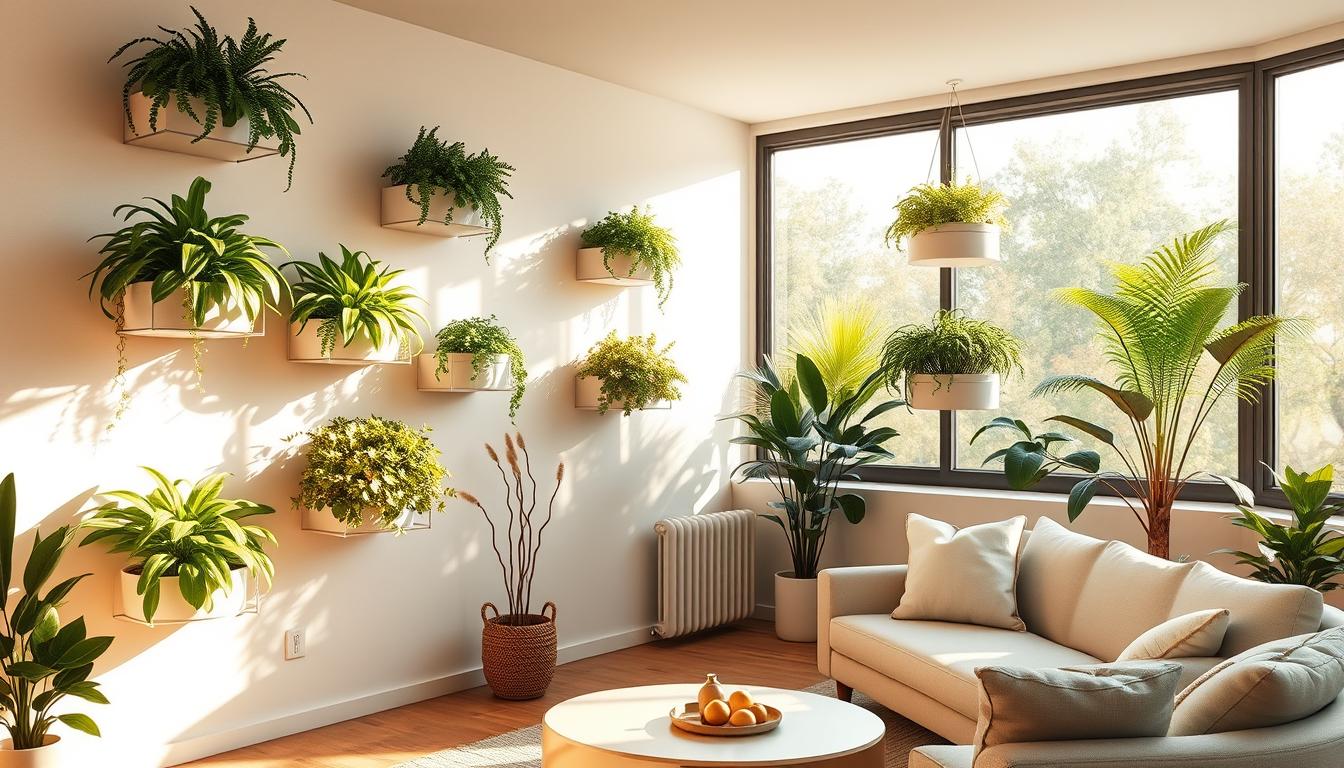Bringing the outdoors inside has never been more stylish or accessible. The trend of vertical greenery is a refreshing way to connect with nature. It doesn’t take up much space.
These hanging garden solutions turn blank walls into living canvases. They add color and texture to any space. Whether you have a big house or a small apartment, they work well.
Wall-mounted planters solve common problems for city dwellers. They make your plants easy to see and keep pets and kids away. They also make your space more interesting.
Ready to change your living space? Let’s see how these decorative elements can transform your home. They offer a perfect mix of beauty and usefulness.
The Rising Popularity of Vertical Gardening
Vertical gardening has become a big trend in home design. It’s a way to bring nature into our homes, even when we have little space. Now, blank walls are turned into vibrant, green spaces.
Why Wall-Mounted Planters Are Trending
Social media has made vertical gardening popular. Instagram and Pinterest are full of beautiful living walls. They show how small spaces can be made green with wall planters.
People want to connect with nature more. Wall planters let us do this without taking up too much space. It’s a way to feel close to nature indoors.
The Intersection of Functionality and Design
Today’s wall planters are both pretty and practical. They solve old problems like watering and damage. They have features like self-watering and drainage, making them easy to use.
Historical Context of Vertical Gardens
Vertical gardening isn’t new. The Hanging Gardens of Babylon were a famous example. Many cultures have used walls for growing plants when land was scarce.
French botanist Patrick Blanc started the modern living wall in the 20th century. His hydroponic systems let plants grow on walls without soil. This changed how we think about plant displays.
Modern Adaptations for Today’s Homes
Vertical gardening has changed to fit different homes. Now, there are modular systems and plants that grow well in various light. Even renters can have vertical gardens with easy-to-use solutions.
Wall planters are versatile. They can be art in small apartments, herb gardens in kitchens, or big statements in living rooms. This has made vertical gardening a common part of home decor.
Benefits of Wall-Mounted Planters in Modern Homes
Modern homes are finding that wall-mounted planters bring many benefits. They change living spaces in exciting ways. These planters are good for both looks and feel of your home.
They are key to making homes look modern and green. Knowing their benefits helps you choose the right plants for your space.
Space-Saving Solutions for Urban Dwellers
For those in small homes, space is precious. Wall-mounted planters are a smart choice. They turn your walls into gardens, saving floor space.
These planters have many advantages:
- They make the most of small spaces
- They use wall space that’s often wasted
- They bring green to tight spots
- They’re great for homes with pets or kids
Improved Air Quality and Wellbeing
Wall-mounted planters do more than save space. They also make your air cleaner and your home healthier.
Physical Health Benefits
Plants clean the air naturally. They take in bad stuff and give out fresh oxygen. Some plants even remove harmful chemicals from the air.
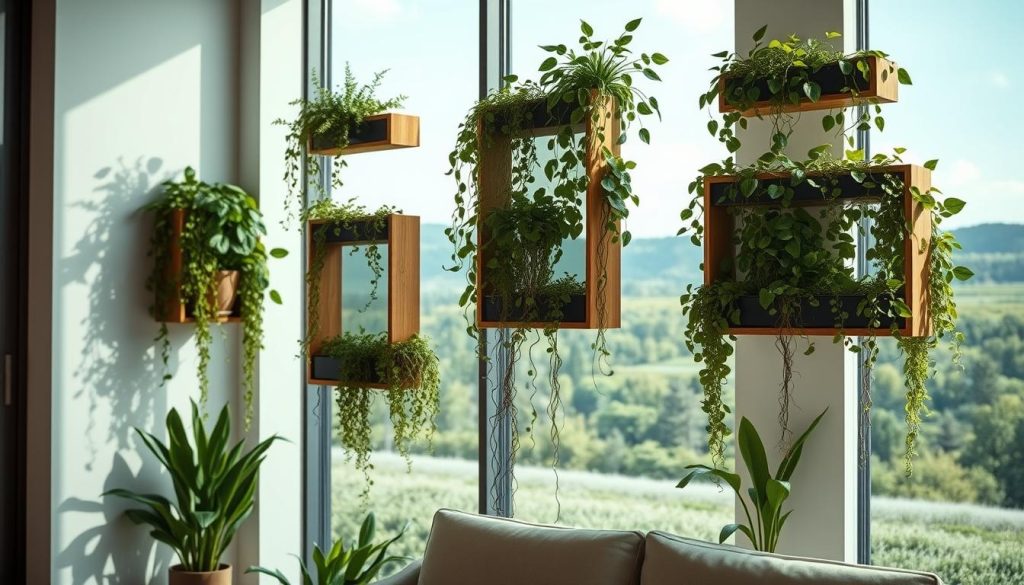
They also add moisture to the air. This helps your skin and lungs, which is good in dry winter air.
Mental Health Advantages
Being around plants is good for your mind too. Studies show it lowers stress and boosts focus.
People feel calmer and more creative with plants around. Even a few plants on walls can make you feel connected to nature.
Adding Visual Interest to Blank Walls
Wall-mounted planters turn plain walls into living art. They change as plants grow, adding interest over time.
The contrast between plants and walls adds depth. Arranging planters well creates eye-catching spots in any room.
Types of Wall-Mounted Planters for Every Style
Choosing wall-mounted planters for your home is exciting. You can find many materials and designs to match your style. Whether your home is modern, industrial, rustic, or eclectic, there’s a perfect planter for you. The right planter not only holds your plants but also adds to your home’s look.
Ceramic and Porcelain Options
Ceramic and porcelain planters add elegance to any room. They come in smooth, glossy finishes or matte textures. You can find them in many colors and patterns, fitting both modern and traditional homes.
Many ceramic planters have simple shapes that look great in modern homes. They are sturdy and won’t let moisture through to your walls.
Metal and Industrial Designs
Metal planters are perfect for urban lofts and modern homes. They have a sleek look and are very durable. You can find them in stainless steel for a modern feel or wrought iron for a vintage look. Powder-coated metal planters come in bright colors, adding a pop of color to your walls.
Metal planters are strong, allowing for creative hanging systems. They often have interesting mounting systems that add to their beauty.
Wooden and Natural Material Planters
Wooden planters add warmth and texture to your space. They come in various woods, from walnut and oak to bamboo and pine. Each piece has its own unique grain pattern.
There are also planters made from rattan, cork, and coconut coir. These materials are eco-friendly and add a rustic touch to your home.
Recycled and Upcycled Alternatives
There are planters made from recycled materials, like tin cans and glass bottles. These planters are good for the environment and add a unique touch to your walls.
Sustainable Materials to Consider
For eco-friendly planters, look for ones made from recycled paper pulp, bamboo fiber, or reclaimed wood. These materials are good for the planet and stylish.
Eco-Friendly Brands Leading the Way
Brands like Ecopots, Biobu, and Eco Planter are leading the green décor movement. They use recycled plastics and biodegradable materials. Their products are not only beautiful but also made with care for the environment.
Creating a Living Wall: Design Principles and Inspiration
When you make a living wall with wall-mounted planters, knowing design basics is key. It makes your green wall a standout feature, not just a mess. It’s about making a botanical display that looks good together.
Think of your wall as a canvas. Each planter adds to the whole picture. Whether it’s a small setup or a big living wall, these tips will make it look intentional and nice.
Balancing Proportion and Scale
The success of your wall-mounted planter display depends on its fit in your space. Proportion is about how planters and wall match up. Scale is how the whole thing looks in the room.
For small walls, pick small planters to avoid clutter. A few small to medium planters work well. Big walls can handle bigger planters or more plants without feeling too full.
Here are some tips for proportion:
- Keep your display to 60-70% of the wall space for a balanced look
- Use different sizes of planters for interest, but keep a style
- Put bigger planters at the bottom or center for stability
- Step back often to check the balance
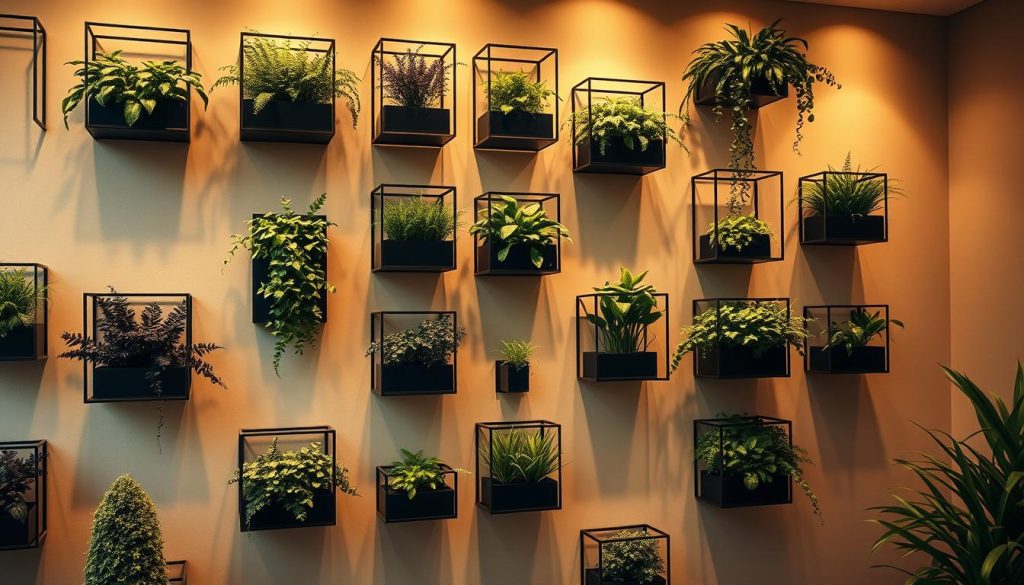
Color Theory for Plant and Planter Selection
Color choices greatly affect your living wall’s mood and look. Think about how plant and planter colors work together with your decor.
Choose planters that match your wall and furniture colors. Neutral planters let plants be the main focus. For more excitement, pick planters that complement your plants’ colors.
Plant colors offer many options. Green plants create a calm look. Adding plants with colors like burgundy or silver adds contrast without being too much.
Pattern and Rhythm in Vertical Arrangements
Visual rhythm in your display guides the eye and adds movement. It can come from repeating shapes, colors, or plants at set intervals.
Change up planter styles or plants to create a pattern. You might use the same planter every third spot or go from small to big plants.
Symmetrical vs. Asymmetrical Designs
Symmetrical designs are formal and balanced, with planters mirrored on both sides. They’re great for traditional spaces or to bring calm.
Asymmetrical designs are balanced but uneven, giving a modern, organic feel. They’re harder to do but can be more interesting and fit unusual spaces better.
Creating Focal Points with Statement Plants
Every living wall needs a focal point to anchor it. A standout plant draws attention and organizes your display.
Choose a plant with unique features like:
- Dramatic vines like pothos or string of pearls
- Plants with interesting shapes like bird’s nest fern or air plants
- Plants with unique colors or patterns
- Plants with big leaves to contrast with small ones
Put your focal point slightly off-center for a natural look. Place it at or just above eye level. This makes a good starting point for viewers to explore your wall.
Best Plants for Wall-Mounted Planters
Not all plants do well in wall-mounted planters. Some plants are better suited for these spaces. They need less water and can grow well in small spaces.
Choosing the right plants is key for a thriving vertical garden. This way, you can enjoy your plants with little effort.
Low-Maintenance Succulents and Cacti
Succulents and cacti are great for wall-mounted planters. They don’t need much water because they store it in their leaves and stems. This makes them easy to care for.
Varieties That Thrive in Shallow Containers
Some succulents do well in small spaces. They grow compactly and need little water. This makes them perfect for vertical gardens.
- Echeveria – These rosette-forming succulents come in stunning colors from blue-green to purple and pink
- Haworthia – Compact, striped succulents that tolerate lower light conditions better than most
- Sedum – Available in trailing and upright varieties with diverse leaf shapes and textures
- Crassula – Includes the popular jade plant and many compact varieties perfect for small spaces
- Sempervivum – Also known as “hens and chicks,” these form tight clusters that multiply over time
Creating Succulent Arrangements
Designing succulent displays is more than just placing plants together. You need to think about color, texture, and how they grow.
Start with a “thriller” plant, like a tall Aeonium. Then add “fillers” like Echeveria. Finish with “spillers” like String of Pearls for a cascading effect.
Use different leaf sizes and textures for contrast. Mix glossy leaves with fuzzy ones. Try pairing colors like purple and yellow or use different shades of green.
Trailing Plants for Dramatic Effect
Trailing plants make vertical gardens look amazing. They create a curtain of greenery that adds movement and drama.
- Pothos – Nearly indestructible with heart-shaped leaves in green, golden, or marbled varieties
- String of Pearls – Features bead-like leaves that dangle on slender stems
- Philodendron – Particular the heartleaf variety, which trails beautifully with minimal care
- English Ivy – Classic trailing plant with variegated options for added visual interest
- Spider Plant – Produces baby “spiderettes” that hang from the mother plant
Herbs and Edibles for Kitchen Walls
Turn your kitchen wall into a herb garden. It’s beautiful and practical. Fresh herbs make cooking better and add fragrance.
Most herbs need the right light for wall planters. Mediterranean herbs like rosemary and thyme do well in dry conditions. Basil, parsley, and mint grow fast and need more water.
- Basil – Available in many varieties from sweet to Thai, with different leaf sizes and flavors
- Mint – Contains spreading roots, so it’s perfect for its own dedicated planter
- Thyme – Low-growing with tiny leaves and excellent for shallow containers
- Chives – Provide vertical interest with their tubular leaves and pretty purple flowers
- Compact Lettuces – Baby greens and microgreens can be grown and harvested continuously
Group plants by their watering needs. Put thirsty plants like basil together and separate them from dry-tolerant ones like rosemary. This makes caring for them easier and looks good.
Air-Purifying Varieties for Healthier Homes
Some plants improve indoor air quality. They remove toxins and release oxygen. NASA found several plants that filter indoor pollutants well.
- Snake Plant – Virtually indestructible with upright, architectural leaves that filter formaldehyde
- Peace Lily – Elegant white flowers and glossy leaves that remove benzene and trichloroethylene
- Spider Plant – Easy-care option that tackles carbon monoxide and xylene
- Boston Fern – Lush, feathery fronds that excel at removing formaldehyde
- Pothos – Versatile trailing plant that filters multiple air pollutants
Place these plants in areas with poor air. A living wall of these plants is a natural air filter and a beautiful decoration.
DIY Wall-Mounted Planter Projects
Turn your walls into living art with handmade planters. They show off your plants and creativity. Making your own planters saves money and lets you have unique pieces that fit your home’s style. DIY vertical gardening is rewarding and adds greenery to your space.
Simple Weekend Projects for Beginners
Even if you’re new to DIY, there are easy wall-mounted planter designs. Use picture frames with chicken wire and small pots for a succulent display. Or make wooden box planters from pre-cut lumber at your local store.
Hanging terra cotta pots with macramé is another easy project. It needs basic knotting skills and cheap cotton rope. This look is bohemian and fits many decor styles.
Upcycling Household Items into Unique Planters
See your home in a new light – many items can become planters. Clean tin cans become chic when painted and mounted. Old gutters make great herb gardens for your kitchen.
Plastic bottles and kitchen containers can be decorated for planters. Make sure to add holes for drainage in non-porous containers. This way, they can hold water.
Advanced Builds for the Crafty Homeowner
If you’re good with power tools, there are impressive projects. Make modular hexagonal planters that grow with your plants. Or build living wall frames with irrigation systems from PVC piping.
Floating shelves with hidden planters offer a modern look. They also hold decorative items. These projects take weekends but result in stunning vertical gardens.
Tools and Materials You’ll Need
- Basic tools: Drill, screwdriver, hammer, level, measuring tape
- Cutting tools: Saw (hand or power), utility knife, scissors
- Fasteners: Screws, nails, wall anchors, picture hanging hardware
- Materials: Wood (reclaimed or new), plastic containers, metal cans
- Finishing supplies: Paint, stain, sealant, sandpaper
Step-by-Step Instructions for Popular Projects
- Wooden box planter:
- Cut cedar boards to desired dimensions
- Assemble using waterproof wood glue and screws
- Drill drainage holes in the bottom
- Sand edges and apply sealant
- Attach mounting hardware to the back
- Tin can herb garden:
- Clean cans thoroughly and remove labels
- Punch drainage holes in the bottom
- Sand any sharp edges and apply primer
- Paint in desired colors and seal
- Mount to a wooden board using pipe clamps
DIY wall-mounted planters let you be creative. Try different materials, colors, and designs until you find the perfect fit for your home.
Wall-Mounted Planters: Installation Tips and Techniques
Turning your walls into green spaces needs careful planning and the right installation. Vertical gardening is beautiful, but mounting planters can seem tricky. With the right steps, you can create a stunning display that will last for years.
Selecting the Right Location
Finding the perfect spot for your planters is key. First, check if your plants need sunlight. Most indoor plants need some indirect light to grow well.
Look for a spot that’s easy to reach for upkeep. A vertical garden that’s hard to get to will soon become a hassle. For kitchen herbs, place them near your cooking area.
Think about how the planters will look in your space. They work best as eye-catching features or to enhance your decor. Measure your wall before buying or making planters to get the right size.
Proper Mounting Techniques for Different Wall Types
The type of wall you have affects how you mount planters. Each material needs its own tools and methods to keep your garden safe and steady.
Drywall Installation Methods
Drywall can’t hold heavy weights without extra support. First, find the wooden studs with a stud finder. These studs are the best places to mount.
For light planters (under 10 pounds), use toggle bolts or drywall anchors between studs. Spread the weight of multiple planters across several studs. Drill holes a bit smaller than your screws to avoid drywall cracks. For heavy systems, attach a mounting board across studs first, then the planters.
Brick and Concrete Solutions
Masonry walls are great for heavy planters but need special tools. Use a hammer drill with masonry bits to avoid damaging the wall. Don’t drill into mortar joints, as they are weaker.
Choose masonry anchors made for brick or concrete. Plastic expansion anchors are good for light loads, while sleeve anchors or concrete screws hold more for big displays. Always wear safety goggles when drilling into masonry to protect your eyes.
Preventing Water Damage and Leaks
Managing water is vital for wall-mounted planters. Even a little moisture can harm walls over time, causing mold, rot, or paint peeling. Make sure each planter has drainage holes to prevent root rot and water buildup.
Use waterproof barriers between planters and walls with plastic sheeting or special backing. Catch trays or built-in reservoirs can hold excess water and add humidity. Some people use felt pockets or fabric planters to spread moisture evenly.
Water your plants carefully to avoid splashing and overflow. Use a small watering can or a spray bottle for better control. Self-watering systems can also keep moisture levels steady without overwatering.
| Wall Type | Recommended Hardware | Weight Capacity | Tools Needed | Special Considerations |
|---|---|---|---|---|
| Drywall with Studs | Wood screws | Up to 50 lbs | Stud finder, drill, screwdriver | Must hit studs directly for heavy items |
| Drywall without Studs | Toggle bolts, molly bolts | 5-25 lbs | Drill, screwdriver | Distribute weight across multiple anchors |
| Brick/Concrete | Masonry anchors, sleeve anchors | 50+ lbs | Hammer drill, masonry bits | Drill into brick, not mortar joints |
| Plaster/Lath | Plaster anchors, toggle bolts | 10-30 lbs | Drill with masonry bit | Drill slowly to prevent cracking |
| Tile | Tile-specific anchors | 5-15 lbs | Tile drill bit, regular drill | Drill through grout when possible |
Maintaining Your Vertical Garden
Keeping your vertical garden healthy is more than just setting it up. It’s about caring for it every day to make sure it stays beautiful all year. Wall-mounted planters are great for showing off plants, but they need special care. With the right watering, seasonal care, and fixing problems, your living wall will stay a stunning part of your home.
Watering Solutions for Wall-Mounted Plants
Watering plants on walls is tricky because of gravity. It’s key to find the best way to water your vertical garden to keep plants healthy and avoid wall damage.
Drip Systems and Self-Watering Options
Drip irrigation systems are a smart choice for wall planters. They send water right to the roots of each plant. These systems have small tubes that hide behind or next to your planters, with settings for each plant.
Self-watering planters are also great for busy people. They have water reservoirs that give plants moisture as needed. Some modern systems have:
- Hidden water tanks that need refilling every 2-3 weeks
- Wicking systems that pull water up from reservoirs as plants need it
- Smart planters with sensors that check soil moisture and water plants automatically
Preventing Over and Under-Watering
Wall planters need the right amount of water. Too much can cause root rot and harm your walls. Too little makes plants stressed and wilted.
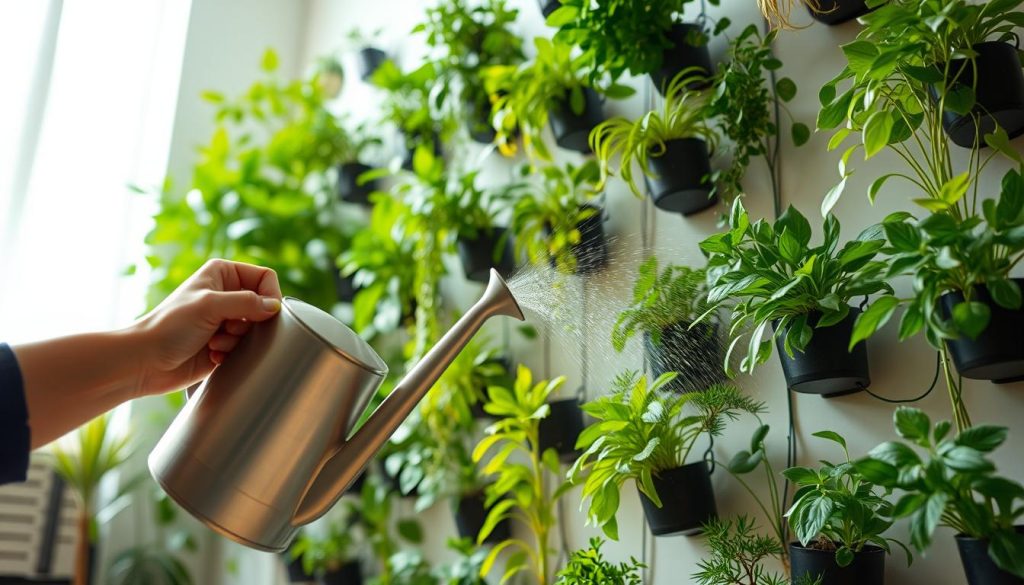
Watch for signs from your plants. Yellow leaves mean too much water, while brown edges mean too little. For most plants, let the top inch of soil dry before watering again. A moisture meter can help you know when to water.
Think about where you put your planters when deciding how often to water. Plants in sunny spots need more water than those in the shade. Smaller containers dry out faster than bigger ones.
Seasonal Care and Rotation
Seasons change, and so do your plants’ needs, even indoors. In winter, most plants need less water and food. But in spring and summer, they grow fast and need more water and food every month.
Light changes with the seasons too. You might need to turn your planters to keep plants growing evenly, if they get sunlight from one direction. Plants grow towards light, so turning them keeps them balanced.
Humidity also changes with the seasons. In dry winters, mist your plants or use a humidifier. This is very important for plants that like humid air.
Troubleshooting Common Issues
Even with good care, vertical gardens can have problems. Catching these early makes fixing them easier and keeps your plants healthy.
Pests can spread fast in wall gardens. Check leaves for spider mites, mealybugs, or scale. Treat them quickly with insecticidal soap or neem oil, which are safe for indoor use.
Problems with nutrients show up as discolored leaves or slow growth. Most plants need fertilizer every 4-6 weeks when they’re growing. Use a weak liquid fertilizer to avoid harming roots in tight spaces.
Root problems happen if plants don’t drain well. When you repot, look for healthy white roots. Brown or mushy roots mean too much water, while dry roots mean too little. Always use fresh potting mix that drains well.
Learning to care for plants takes time. Don’t worry about mistakes—most problems can be fixed with a little observation and adjustment. With regular care, your wall garden will keep your home beautiful and the air fresh.
Styling Wall-Mounted Planters in Different Rooms
Wall-mounted planters can be styled in many ways to fit each room’s look and feel. By thinking about each space’s unique qualities, you can make green displays that are not only pretty but also healthy. Let’s see how to use these versatile garden pieces in different rooms.
Living Room Arrangements for Maximum Impact
Your living room is a great spot for eye-catching plant displays. Try grouping different planters above your sofa or fireplace. Use various sizes, shapes, and heights to add interest.
For modern rooms, use geometric metal planters with plants like pothos or philodendron. Traditional rooms look nice with ceramic wall pockets and ferns or spider plants. Choose plants that match your room’s colors—plants with silver leaves go well with cool colors, while red-tinged plants brighten warm spaces.
Bathroom Oases with Humidity-Loving Plants
Bathrooms are perfect for plants that love humidity. The steam from your shower makes a great home for tropical plants. Place planters near the shower but not in the direct spray for best results.
Boston ferns, peace lilies, and orchids are great for bathrooms. They make the space feel like a spa. In small bathrooms, use vertical planters to save space and keep counters clear.
Kitchen Herb Gardens for Function and Beauty
The kitchen is the best place for wall-mounted planters, like herb gardens. Having fresh herbs nearby makes cooking easier and adds color and scent to your kitchen.
Put herb gardens near sunny windows for 4-6 hours of light. If it’s not sunny enough, use grow lights for herbs. Arrange planters so you can easily reach the herbs you use most.
For looks, mix herbs with different textures and heights. Rosemary can spill over from tall planters, while thyme and oregano fit in smaller ones. Add edible flowers like nasturtiums or pansies for color.
Bedroom Sanctuaries with Calming Greenery
Bedrooms need plants that help you relax and sleep better. Choose plants that are easy to care for and won’t disturb your sleep.
Plants That Promote Better Sleep
Some plants help you sleep better. Lavender’s scent lowers your heart rate and blood pressure, making it great for beside your bed. Snake plants clean the air at night, improving sleep quality.
Jasmine and gardenia also help you sleep with their calming scents. English ivy reduces mold particles that can cause allergies at night.
Arrangement Ideas for Small Spaces
In small bedrooms, use vertical gardening to save space. Make a plant headboard with small planters above your bed. For tiny apartments, use corner planters to make the room look bigger.
Use magnetic planters on metal surfaces for renters. Or, try tension rod systems for lightweight planters without damaging walls.
| Room | Recommended Plants | Planter Style | Benefits |
|---|---|---|---|
| Living Room | Pothos, ZZ Plant, Spider Plant | Decorative ceramic, geometric metal | Visual impact, air purification |
| Bathroom | Ferns, Orchids, Peace Lilies | Water-resistant materials, drainage systems | Humidity absorption, spa-like atmosphere |
| Kitchen | Basil, Mint, Thyme, Rosemary | Tiered herb planters, labeled containers | Fresh cooking ingredients, aromatic benefits |
| Bedroom | Lavender, Snake Plant, Jasmine | Simple, low-profile designs | Better sleep quality, calming environment |
Innovative Wall-Mounted Planter Systems for Modern Homes
Today, wall-mounted planter systems are changing how we add greenery to our homes. They solve common problems for indoor gardeners and make vertical gardens look great. These systems have smart features, can be customized, and save water, making plant care easy.
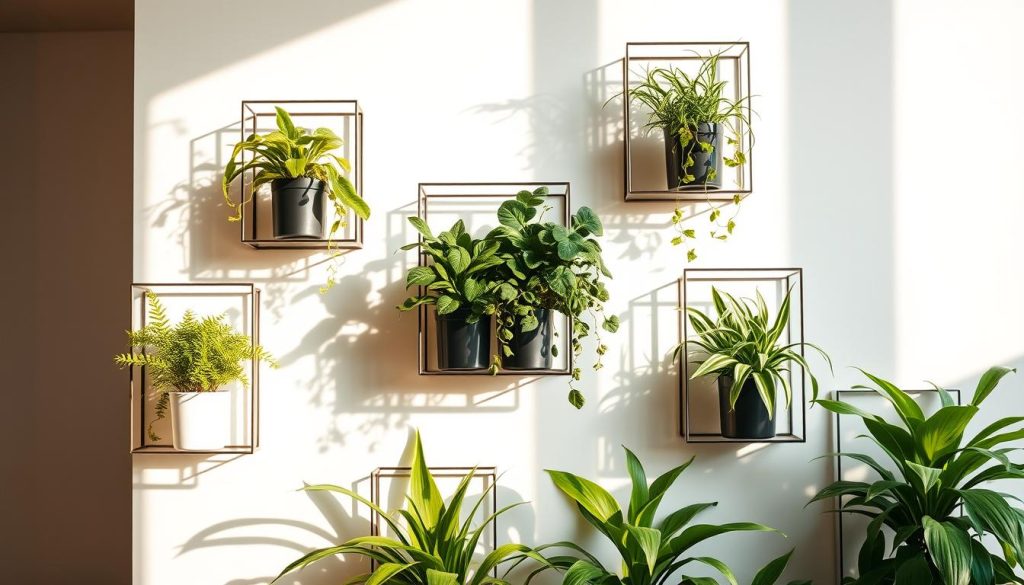
Modular Systems for Customizable Displays
Modular planters are very flexible in vertical gardening. You can add or change units as your plants grow or your style changes. They come in different sizes to mix and match for unique displays.
Wallygro and Lechuza make modular planters that are easy to connect. You can start small and grow your display over time. Some even have special modules for different plants, like succulents and ferns.
Self-Watering Options for Busy Plant Parents
Self-watering planters are great for those with busy lives or who travel a lot. They have water reservoirs that slowly feed plants, so you don’t have to water as often.
These systems use different technologies, like wicking or water level indicators. Some, like the Florafelt Pocket system, use capillary action. Others have membranes that release water when the soil gets too dry.
Smart Planters with Integrated Technology
Smart planters combine gardening with smart home tech. They have sensors that check soil moisture, light, temperature, and nutrients. You get alerts on your phone when plants need care.
Some smart planters have grow lights that adjust on their own. Others have automated watering. While they cost more, they save time and help your plants thrive.
Vertical Hydroponic Systems for Indoor Gardening
Vertical hydroponic systems are the most efficient for growing plants indoors. They use water with nutrients, not soil, for faster growth and more yields in less space.
Click and Grow’s Smart Wall and the Lettuce Grow Farmstand are great for growing herbs and veggies indoors. They’re easy to set up and need less maintenance. This means less mess and more control over your plants.
Bringing the Outdoors In: The Transformative Power of Living Walls
Living walls touch something deep inside us. Walking into a room full of plants is more than just pretty—it’s our connection to nature. This natural bond with living things makes wall-mounted planters so impactful on our spaces and health.
People living in cities with little outdoor space find vertical gardens a lifeline to nature. A study by the University of Technology Sydney shows indoor plants can cut stress by up to 37%. Imagine what a whole living wall could do! These green walls clean our air, block out noise, and even control room temperature.
“My living wall changed everything,” says Sarah Miller from Chicago. “It’s not just decoration—it’s the heart of my apartment. Friends gather around it, and I sleep better since installing it.”
The charm of wall-mounted planters is their flexibility. Begin with a single planter in your kitchen for herbs, or turn an entire wall into a green oasis. Each plant you add brings you closer to the natural world we all need.
Starting your vertical gardening journey? Remember, living walls do more than look good—they bring life to our homes. They remind us, even in the most urban areas, we’re still part of nature. Your wall-mounted garden is waiting—what will you grow?

